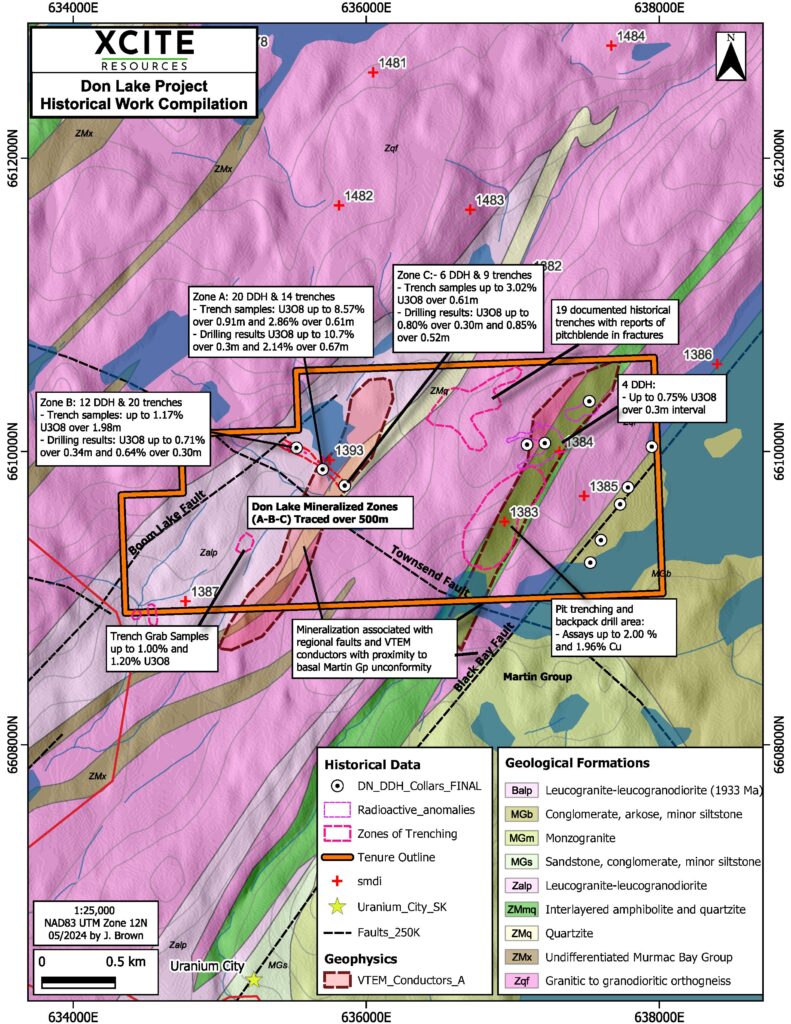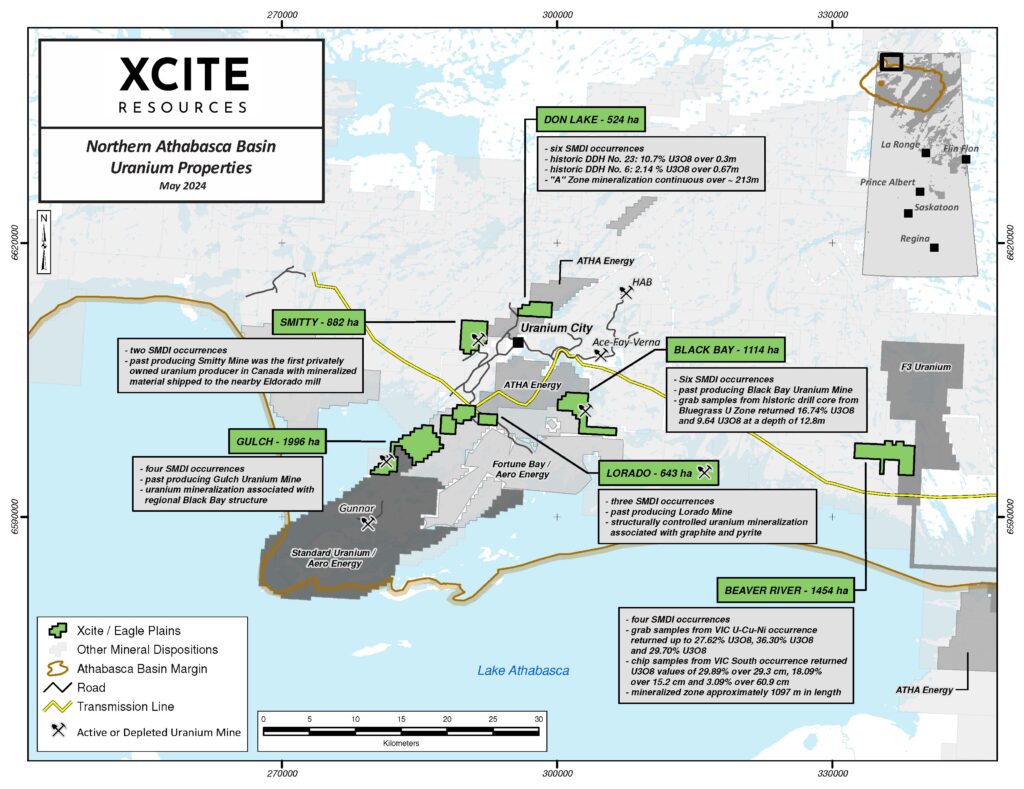Vancouver, British Columbia, May 09, 2024: Xcite Resources Inc. (CSE:XRI) (“XRI or Xcite”) and
Eagle Plains Resources Ltd. (“EPL”:TSX-V, or “Eagle Plains”), have received the results from a data
compilation on the Don Lake uranium project, located 4 km NE of Uranium City, Saskatchewan. The
Don Lake project hosts near-surface high-grade uranium. The compilation and interpretation of available
data will lead to recommendations for 2024 fieldwork.
Don Lake Data Compilation Highlights :
- Six uranium mineral showings on property, spatially related to cross-faulting and regional Boom
Lake and Black Bay faults. - Structurally controlled mineralization associated with EM conductors.
- Excellent infrastructure – road-accessible from Uranium City.
- Property underlain by Archean granitic gneisses of the Tazin Group, prospective rock-types for
Beaverlodge-style basement-hosted U mineralization. - Historical drilling that tested structurally controlled uranium mineralization in faults and fractures
returned up to 10.7% U3O8 over 0.3m (DDH No. 23) and 2.14% U3O8 over 0.67m (DDH No. 6).

About the Don Lake Project
The road accessible 524ha project overlies 6 Saskatchewan Mineral Deposit Index (“SMDI”) occurrences
associated with Beaverlodge-type basement hosted uranium mineralization.
The property is transversed by the parallel, northeasterly-striking Boom Lake and Black Bay Fault, the
latter of which is a regional structure that is inferred to control uranium mineralization in the Beaverlodge
camp. In the southeast corner of the property Martin Group sediments form an unconformable contact with
older Tazin Group gneisses, along the hanging wall of the Black Bay Fault.
Uranium mineralization at Don Lake is structurally controlled, occurring as pitchblende hosted in fractures
and veins associated with faults and shear zones, and often associated with graphite and sulphides.
Three zones of radioactivity and uranium mineralization have been identified at the Don Lake A, B and C
Zones (SMDI 1393), which has been traced by historical drilling and trenching over approximately 525m.
Zone A is a vein system with a length of 213.4 m, that crosses the trend of a northeast-striking lineament.
Fourteen trenches and 20 shallow drill holes have been completed over the zone. Analytical results range
from trace values up to 8.57% U3O8 over 0.91m and 2.86% U3O8 over 0.61m in trenching and 10.7%
U3O8 over 0.3m and 2.14% U3O8 over 0.67m in drilling (AF74N10-0422).
Zone B, positioned to the northwest and interpreted to be a continuation of the mineralized trend observed
at Zone A, has seen 12 shallow diamond drill holes and 20 trenches completed. Trench sampling reported
grades as high as 1.17% U3O8 over 1.98m, with drilling results including 0.71% U3O8 over 0.34m and
0.64% U3O8 over 0.3m. The uranium mineralization occurs in series of veins and fractures.
Zone C is positioned to the southeast of Zones A and B and further defines the NW-SE mineralized trend.
6 shallow drill holes and 9 trenches have been completed at Zone C, where trench samples returned from
trace amounts up to 3.02% U3O8 over 0.61m and drilling intercepts included 0.80% U3O8 over 0.3m and
0.85% U3O8 over 0.52m.
At Radioactive Occurrence 50-CC3-10 and -44 (SMDI 1383), and the Midas Cu-U Showing (SMDI 1384)
pitchblende occurs as in shears associated with the Crackingstone Fault. Showings associated with the
Townend Fault Uranium Showings (SMDI 1385) host pitchblende in fracture splays and breccia zones. A
10 ft (3.1 m) channel sample taken across a width of 1.0 ft (0.30 m) assayed 1.63% U3O8. (AF74N10-
0056).
At the A.R. Hawker Trench, ARH-2 (SMDI 2116), structurally controlled uranium and sulphide
mineralization is associated with net textured quartz veins. Grab samples from trenches and surface
showings returned from trace values up to 1.2% and 0.78% U3O8 (AF74N10-0453).
“We are excited to share the results from our recent data compilation of the Don Lake Uranium Project,
which have significantly advanced our understanding of the mineral potential on-site,” said Jean-Francois
Meilleur, the CEO and Director for Xcite Resources Inc. “This pivotal update not only maps out our high-
grade uranium findings but also sets a detailed plan for our fieldwork in 2024, aiming to maximize the
project’s value for our shareholders.”
Don Lake History
Anomalous radioactivity at Don Lake was first noted by the Geological Survey of Canada in 1948, with
the first claims recorded later that year by the Eldorado Mining and Refining Company. In 1950, Aurora
Yellowknife Mines identified 28 radioactive occurrences on the property, including the 50-CC3-10 and
50-CC3-44 (SMDI 1383), Midas Cu-U Showing (1384) and Townend Fault Uranium Showings (SMDI
1385). The same year Eldorado completed three short diamond drill holes at the Don Lake Zone A
showing (SMDI 1393), with hole D-1 returning 2.0% U3O8 over 0.6m from 49.7-50.3m (AF 74N10-
0345).
Between 1948-1968, various operators conducted work within the current Don Lake tenure, including
prospecting, scintillometer surveying, trenching and limited diamond drilling. Most of this work is poorly
documented. The next significant work was by Matrix Exploration in 1969, who carried out prospecting,
scintillometer surveying, trenching and the 1200m of diamond drilling in 37 holes at the Don Lake A, B,
and C Zones. Trenching in the A Zone returned from trace values up to 8.57% U3O8 over 0.91m and
2.86% U3O8 over 0.61m. The best drill intercept was from Zone A, where hole 23 returned 10.7% U3O8
over 0.3m (AF 74N10-0422).
Between 1971-78 August Hawker, Matrix Exploration and Kodiak Developments carried out prospecting,
scintillometer surveys, trenching, and ground geophysics on various areas of the current Don Lake tenure.
Parts of the property were covered by airborne geophysics flown by Greater Lenora Resources Corp in
1997 (EM) and by the Geological Survey of Canada and Saskatchewan Energy and Mines who contracted
Sander Geophysics to obtain gamma-ray spectrometric, aeromagnetic and VLF-EM data.
Rock grab samples are selective samples by nature and as such are not necessarily representative of the
mineralization hosted across the property. The above results were taken directly from the SMDI
descriptions and assessment reports (AF) filed with the Saskatchewan government. Management cautions
that historical results were collected and reported by past operators and have not been verified nor
confirmed by a Qualified Person, but form a basis for ongoing work on the subject properties.
About the Beaverlodge Uranium District

The Don Lake, Black Bay, Don Lake, Gulch, Larado, and Smitty projects are located in the
Beaverlodge District near Uranium City in the Lake Athabasca region of Saskatchewan. Occurrences of
uranium mineralization are abundant in the Uranium City area and have been explored and documented
since the 1940s. The Beaverlodge camp was the first uranium producer in Canada, with historic production
of approximately 70.25 million pounds of U3O8 between 1950-1982, from ore grades averaging 0.23%
U3O8. The two largest producers were the Eldorado Beaverlodge (Ace-Fay-Verna) mine and the Gunnar
uranium mine. The Beaverlodge area has seen limited uranium-focused exploration since the early 1990’s.
Eagle Plains’ management cautions that past results or discoveries on proximate land are not necessarily
indicative of the results that may be achieved on the subject properties.
Beaverlodge-style uranium deposits host structurally controlled, high-grade mineralization in veins and
breccia-fills within basement rocks. Mineralization often occurs at geological contacts and consists of
structures filled with hematite, chlorite, and graphite associated with pitchblende.
Qualified Person
Technical information in this News Release has been reviewed and approved by C.C. Downie, P.Geo., a
director and officer of Eagle Plains, hereby identified as the “Qualified Person” under N.I. 43-101.
About Xcite Resources Inc.
Xcite Resources is an early-stage exploration company working to become a leader in the discovery and
development of energy transition metals. The uranium project portfolio in the Athabasca Basin will propel
our efforts to achieve a high-grade discovery.
https://xciteresources.com
Contact:
Jean-Francois Meilleur
CEO & Shareholder,
jfmeilleur@paradox-pr.ca
+1 514 951 2730
